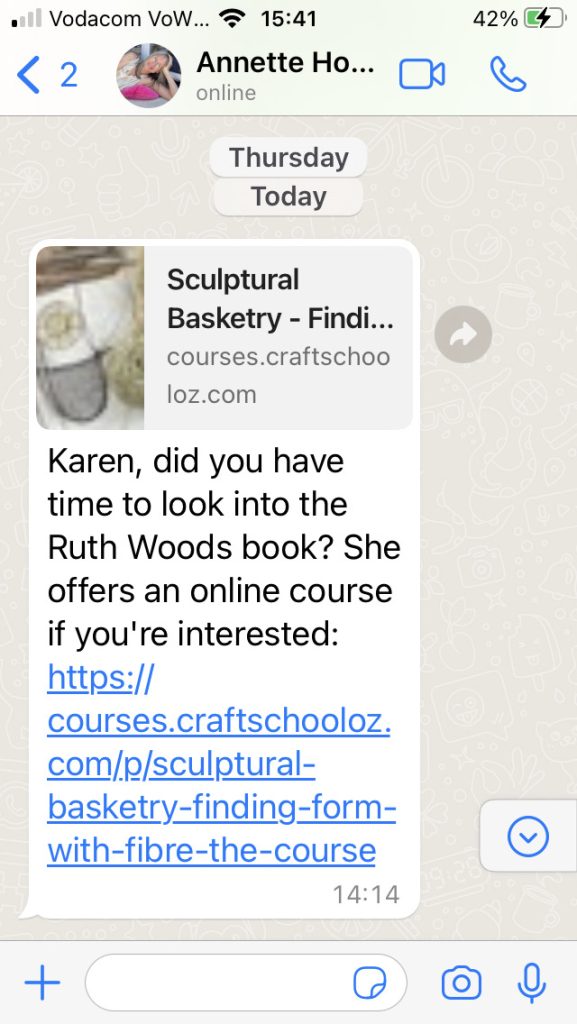INTRODUCTION
This post will be a time-based blog in the form of writing/documenting and responding to conversations and discussing ideas about vessels and making between Annette Holtkamp (OCA textiles student and part of a crit group) and me.
I share this work with the assessors as it shows peer interaction, discussions around work, and the influence of conversation around making and thinking about materials. Our discussions led to a Whats Up group, and more students joined. We are in contact daily – open discussions and sharing of work, ideas, and support. This writing demonstrates my interest in materials, influence by learning from others and material explorations during the course. Looking at my research practice, this work is a story about making and learning, which links to research around Ursula le Guin’s writing and to ideas around care in the work of Maria Puig de la Belacasa.
Link: https://karenstanderart.co.za/the-thing-with-vessels/
Date: 27 May 2023
Annette Holtkamp (OCA Textile student in the OCA EU group) wanted to write about her current exploration of making vessels in her making practice, and we decided to share our writing and react to each other’s ideas. Below is a vessel she shared (22/04/2023) made with rhubarb skin. The vessel and others that followed showed so much transparency, and I sensed vulnerability. I wanted to respond with a drawing when she shared her vessel below. I admire Annette’s photographic skills, as the images show their transparency so well in her photographs I almost feel I can touch them.
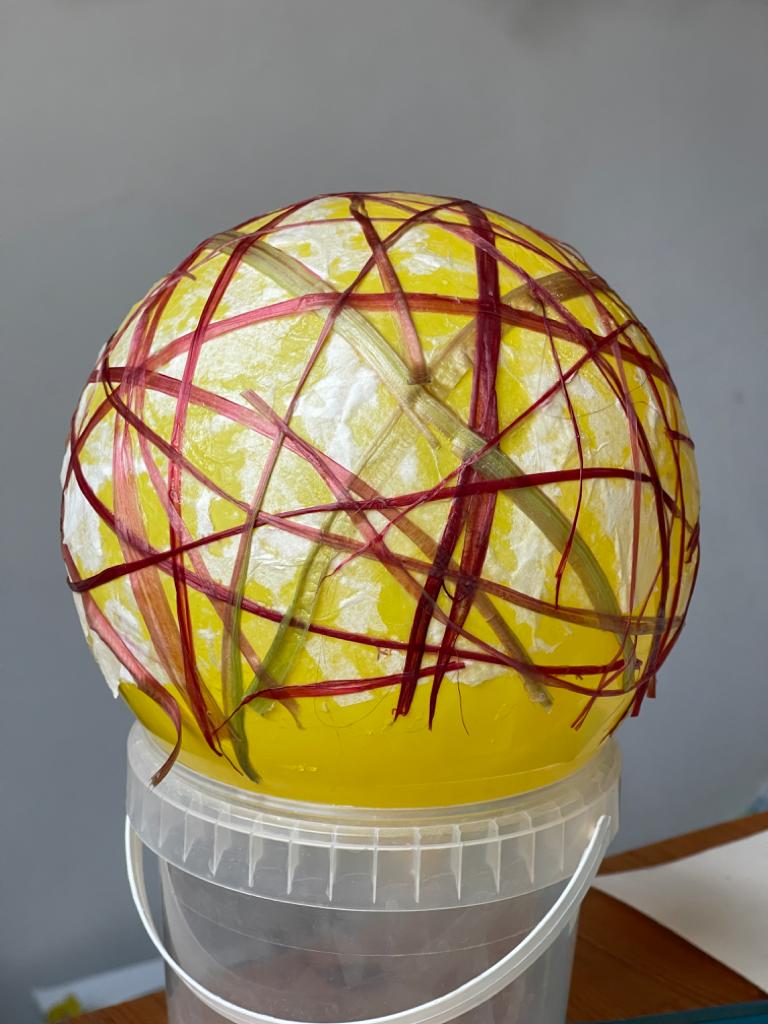
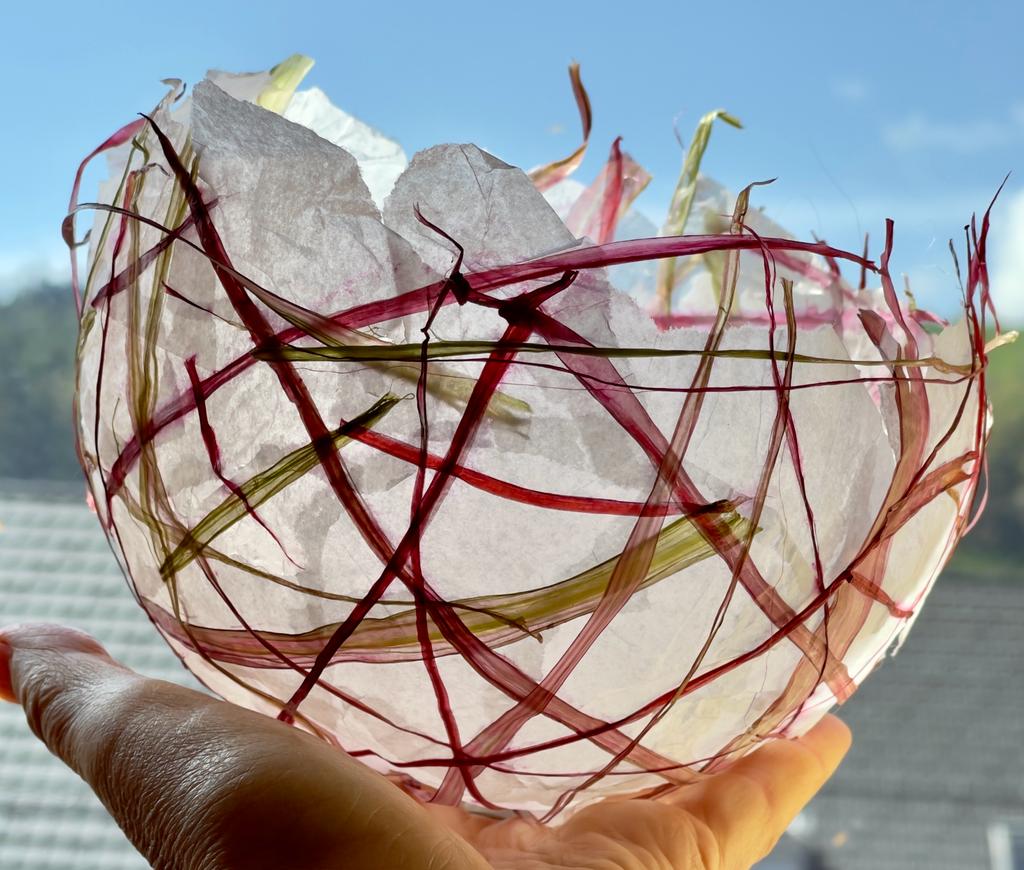
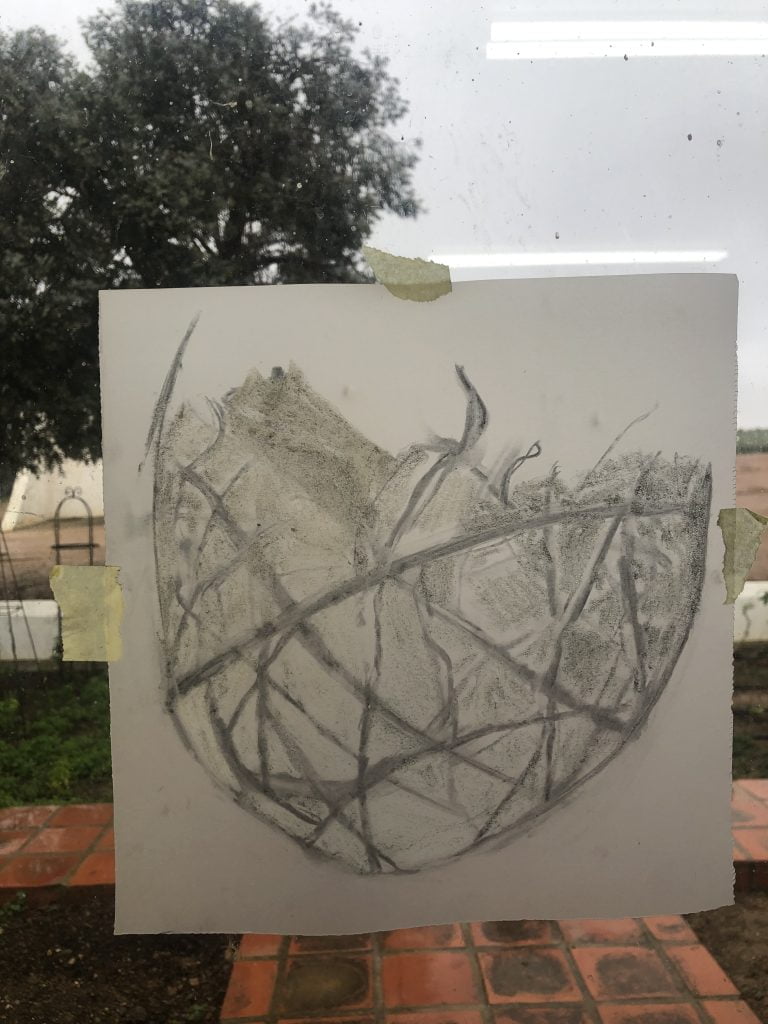
Making a story for the conversation
I came upon making vessels during my exploration with feathers; to me, it became a symbolic container, a personal experience of working through grief. I was trying to get to grips with my son’s death, a life-changing effect on my life as the reality struck that it was an irreversible loss. I found myself in a new, unfamiliar place. I read that the Sanskrit word for pot, Kumbh, means body, and in this way, it could be seen as a manifestation of ‘mother’ and talking to me about caring. The Kumbha is also a repository for mortal remains and is seen as a keeper of spirits.
I think a vessel is a thing of beauty and an embodiment of ‘the ideal’, in terms of its balance and centre of gravity and that one can create beautiful curves and decorate it. This takes me to the Moon Jar in Korean culture, initially made during the Joseon Dynasty (1392-1897). The form of these vessels was thought to represent women’s fertility and gentle qualities – again, caring comes to mind. The form references the Full Moon, hence their name. I enjoy them because they are not entirely symmetrical, have minimalistic off-white colouring, and show imperfection. Is it that this embodies a type of empathy to life for me? Did it remind us of the imbalances and flaws we all carry? (my son died on a full moon evening in January 2023). The moon jar is embedded in Korean ideas about beauty, the spirit, mentality, and emotion grounded in the making. The Buddhist saying about beauty is apt in these vessels: “If you search for beauty, you will not find it. Not searching for beauty is beauty.”
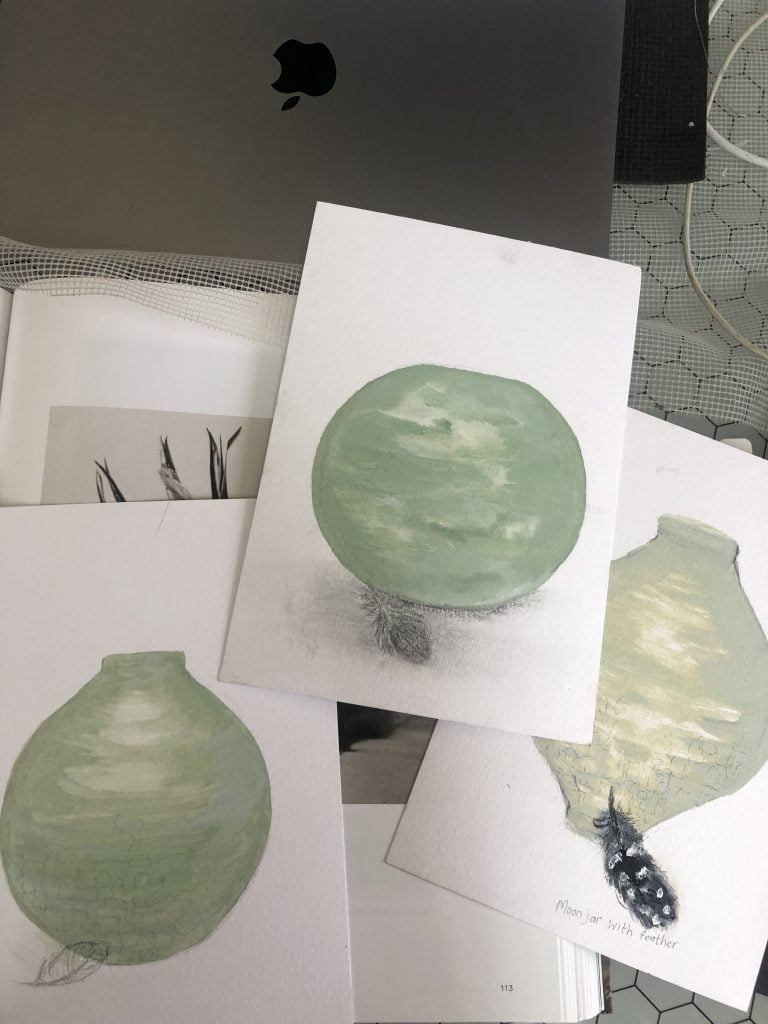
The first vessel I made was with feathers and paper mache, and I realized that the shape became important: it was as if it replaced my hands (a type of space) trying to cradle/hold and became a symbol of comfort and tenderness for pain and loss. It made me realise the signifying importance of a vessel to me, and I found a way to deal with it. My first idea of making a vessel was to go to clay, but I held back from it and responded with the feathers I was working with. I found images of shaman vessels in a google search, and I have never seen vessels made with feathers! This also led to exploring paper mache as a way to create vessels. (early April 2023)
Looking at vessels in history, I also looked at Pandora’s jar: She was the first woman, according to Greek mythology, to be endowed with many gifts by the gods. One of the gifts was a pithos (pottery jar), which she was warned never to open. Curiosity won over caution, and she opened the jar, releasing death and many other evils into the world. But one thing remained in the jar, something that would help humanity triumph over all adversity – and that was hope.
When creating vessels as a part of my work, I want to consider their material properties and how they embody the container concept. In doing so, I believe that vessels hold power as a physical object and a metaphor for the relationship between me and the vessel.
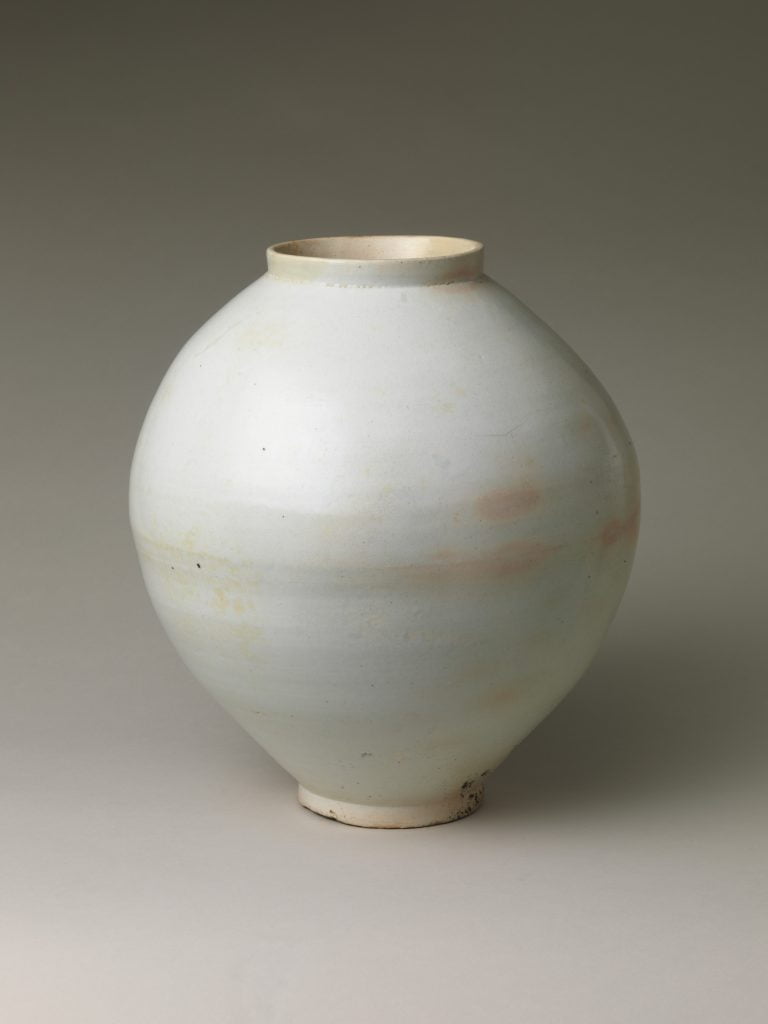
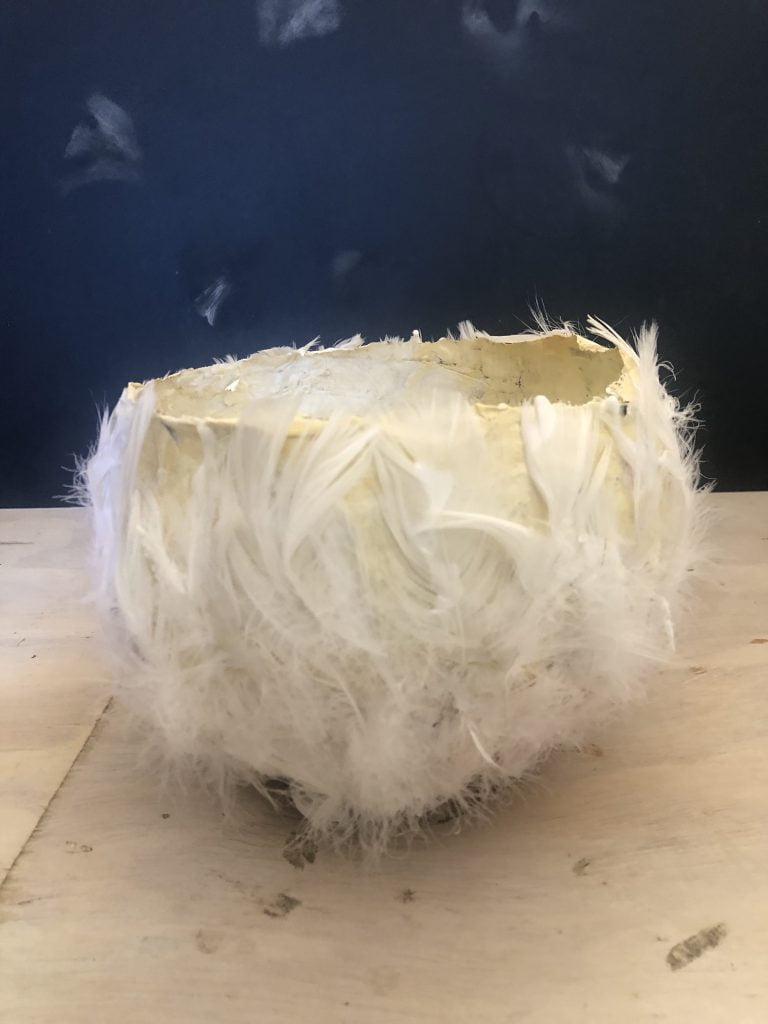
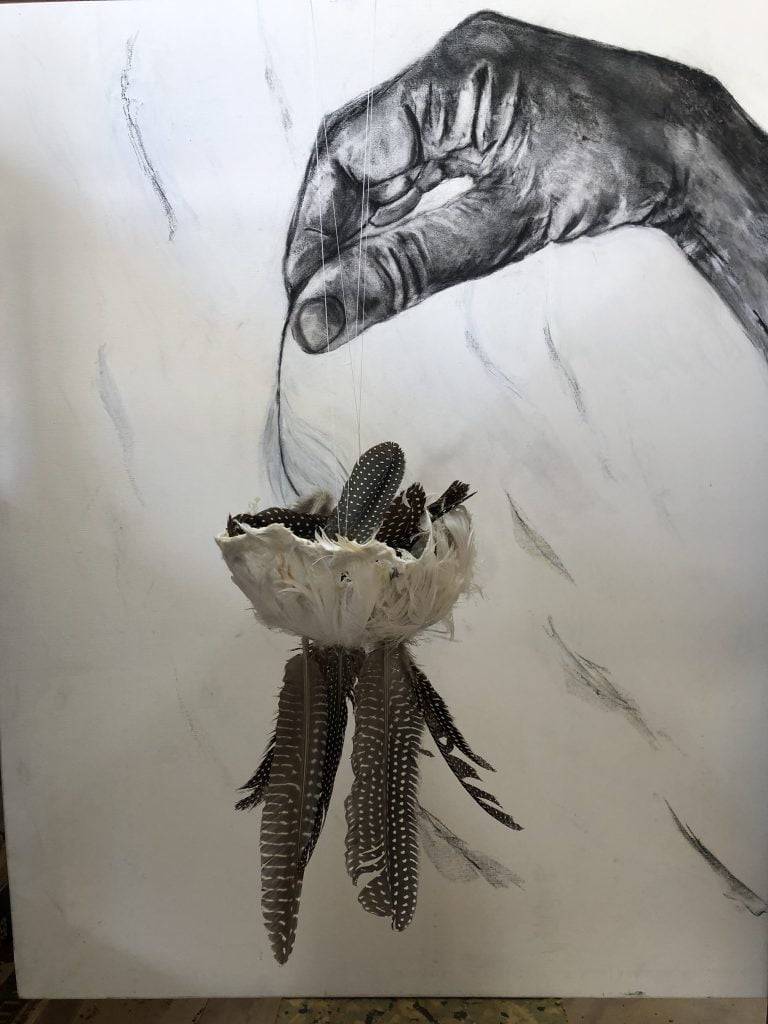
By way of example, studio potter Bruce Kitts explains his interest in ceramics in an interview in Mendocino Arts Magazine:
“I choose to work with clay because I find it is the most inviting medium to have a conversation with . . . Through its extreme malleability, multiple transitions and physical stages, and unusual ability to retain memory, clay speaks to us in many ways.”
Bibliography
Brinck, I., Reddy, V. 2020. Dialogue in the making: emotional engagement with materials. Phenom Cogn Sci 19, 23–45 https://doi.org/10.1007/s11097-019-09629-2. CR31. Accessed on 27 May 2023
Pots & Vessels and the Philosophy of Plentitude. https://artsandculture.google.com/story/pots-vessels-and-the-philosophy-of-plentitude-mode/-gWBFN3kKhydJQ?hl=en. `Accessed on 27 May 2023
List of images
Moon jar Metmuseum.org
Reply from Annette Holtkamp
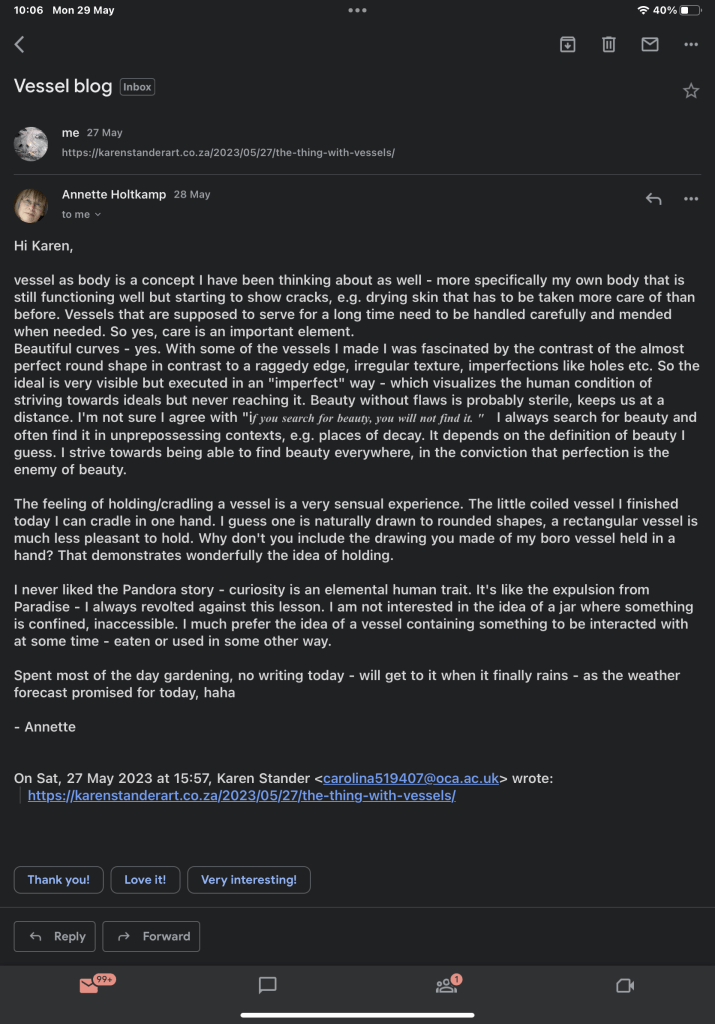
30 May 2023
Annette, I considered how we started sharing thoughts about vessels and making in our different practices. I have an image you shared on WA on 14 October 2022: a work by Gizealla Warburton. You wrote that you were ‘utterly captivated’, and I reacted to how my interest increasingly develops into how results of making across media can have a conversation. (I think kinship started to play a role in my work?). Could this have been the provocation for making? I enjoy how things come into our space and take their time to become ‘the thing” that preoccupies us.
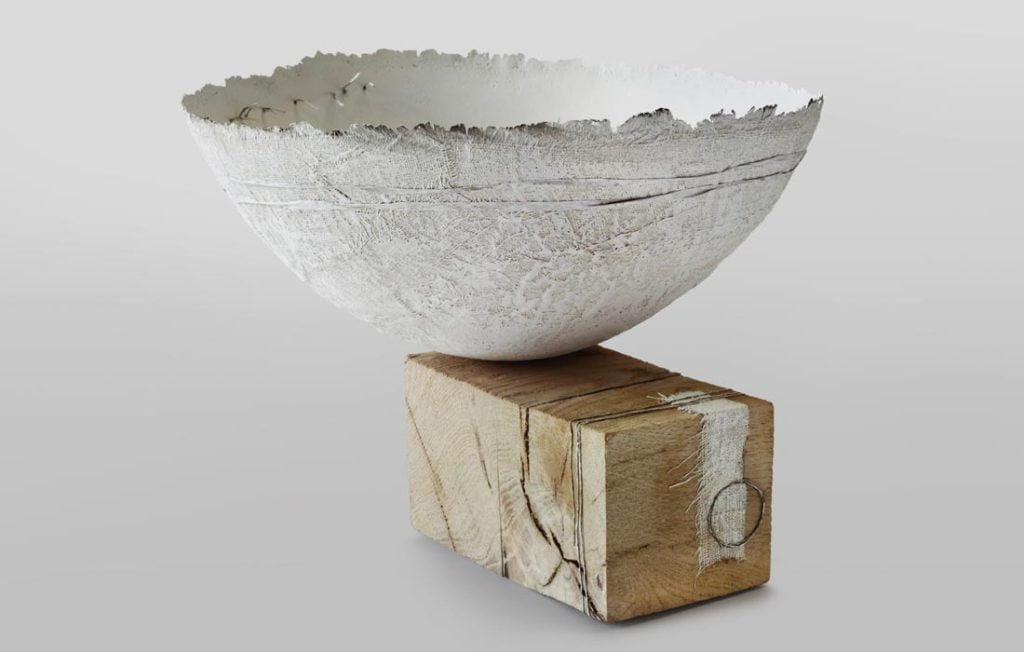
Months later (shortly after my son died), you shared a personal experience, and I think we both let our vulnerabilities come to play between our making and conversations on WA. A paper mache vessel you shared contained a personal story made with scraps of journal pages and some stitching. I think a form of kinship between our ideas around vessels was established. You shared a few photos of the vessel as a WIP.
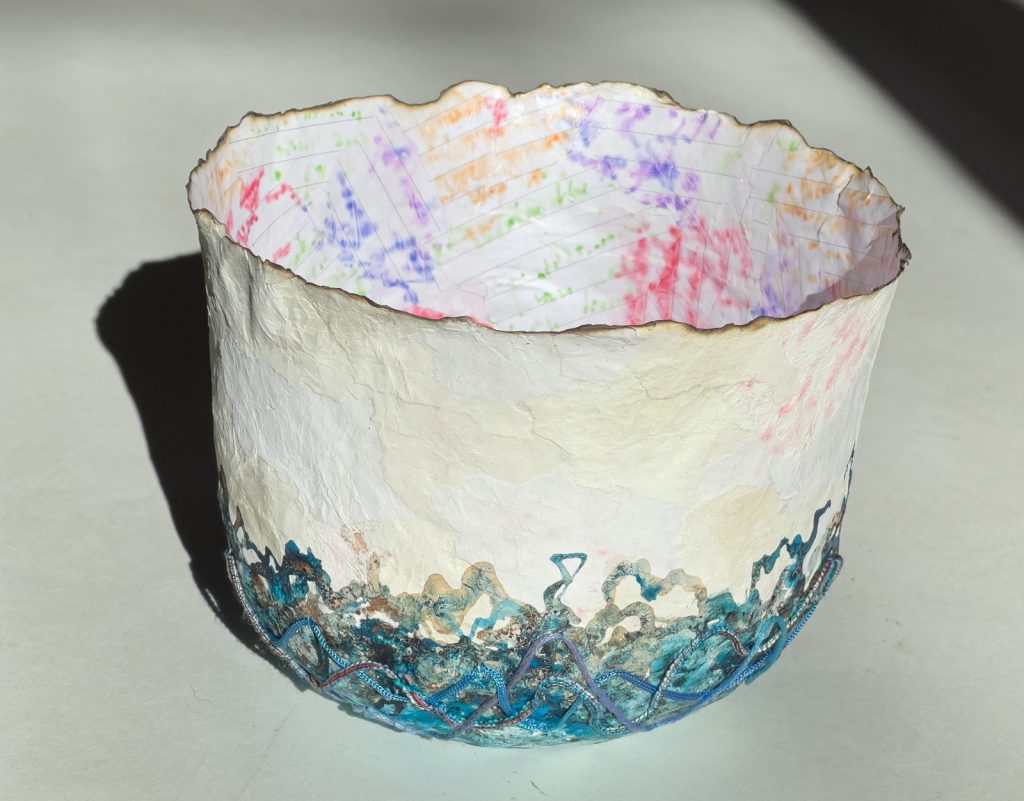
I love how you relate care to your dealing with ageing. After recently breaking my leg and ankle, I am much more aware of signs of ageing in my body and how I need to use this body (vessel) with care and consider maintenance. Doing a little research on vessels, I became aware that before the age of consumerism, previous generations took better care of vessels. Mending, rather than replacing, was the solution, and it reminds us that vessels are, after all, essential to human survival and asks questions about how we care for the essentials in life. In my work, I became more aware of the disconnect between humans and nature (inanimate). I love that a vessel can be linked to this question as well. I do think we are concerned in our making to think about the vessel and shape and its symbolic function.
With regards to the Korean Moon Jar, I think I love the idea of a container carrying ideas of usefulness and modesty. I remember reading Alain de Botton Art as Therapy, where he concedes that: “..Its flaws merely concede its disinterest in the race for status. It has the wisdom not to ask to be thought too special. It is not humble, just content with what it is.” (de Botton, 2013, p38)
In April 2023, we discussed the work of Kate MccGwire, which inspired me to work with feathers in 3d form after I consulted with a local artist about using feathers in recent installation work.
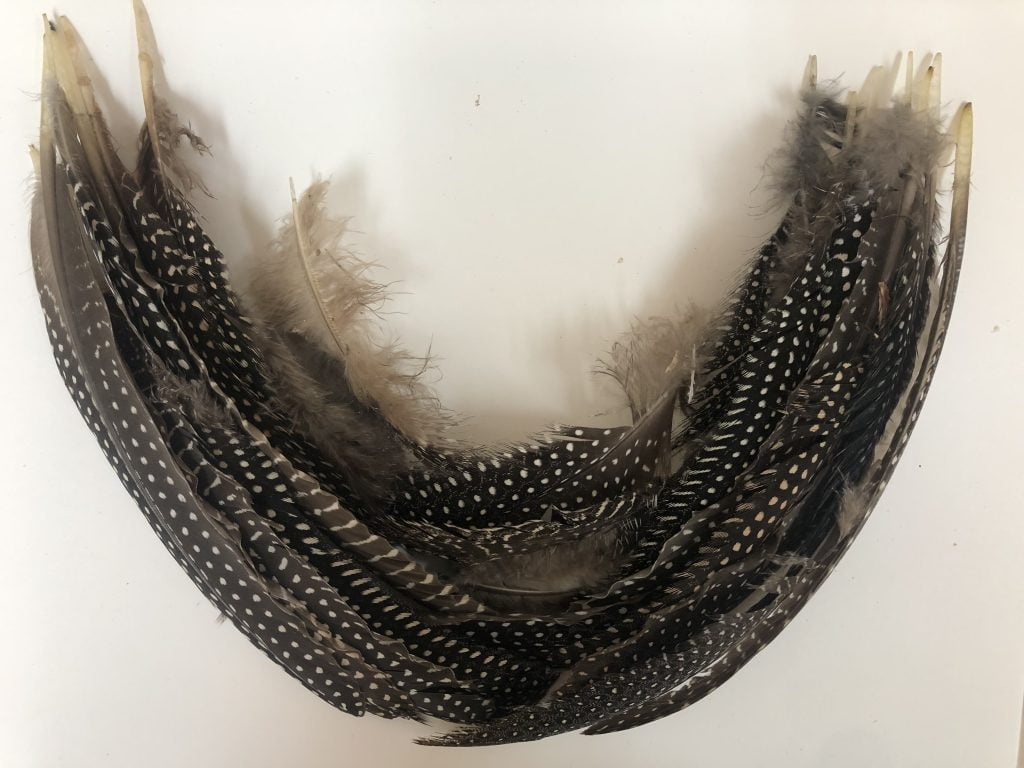
Your ideas about keeping the feathers unconstraint. My reaction to MccGwire’s work is that they disturb, in a way, how they become a new “creature”. I think that morphing into another, almost hyperreal, touched me. I was also not prepared to go there – the beauty of feathers and their soft meaning was much too personal to create objects that almost fight against their beauty. For the work above, you asked: “Why not just knot the quills together and let it swing? like a hammock”. Looking back at this idea, I found it accessible and not in a ‘cage’ as you vehemently fight against it. This could ask that I think differently about making – finding new ways to work with feathers. This will lead to further explorations of using thread/wire to hold together and form a vessel of sorts.
I giggled a bit about your reluctance to give your vessels ‘legs’ and wondered if it relates to my ideas of morphing I saw in the work of Kate MccGwire.
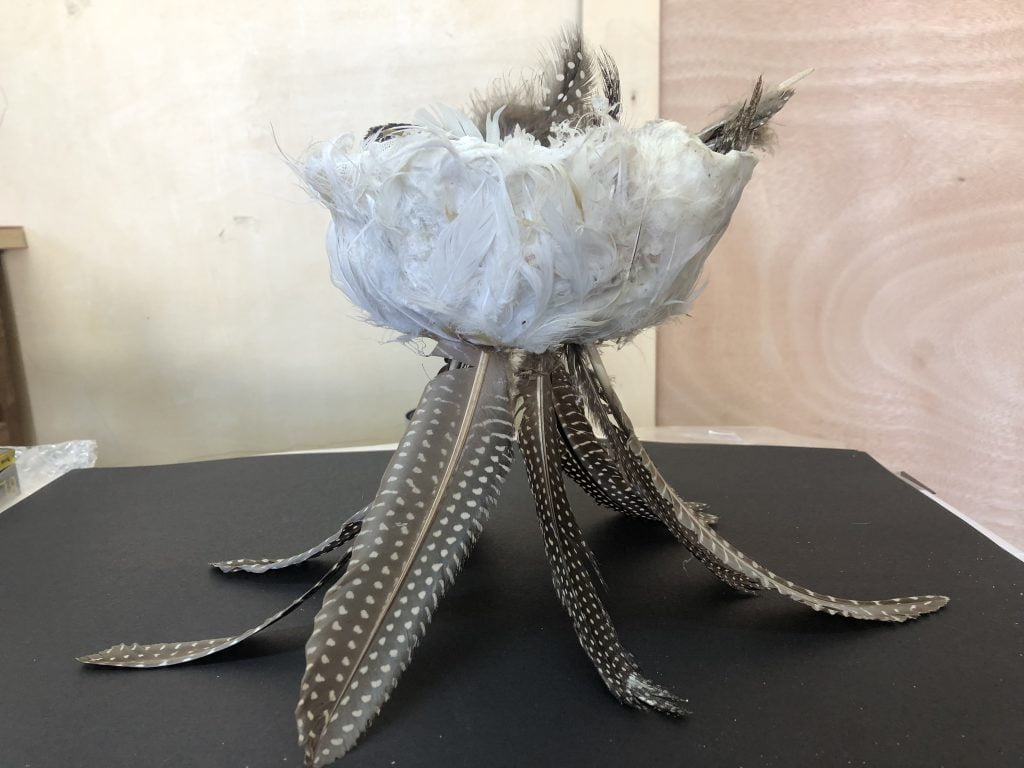
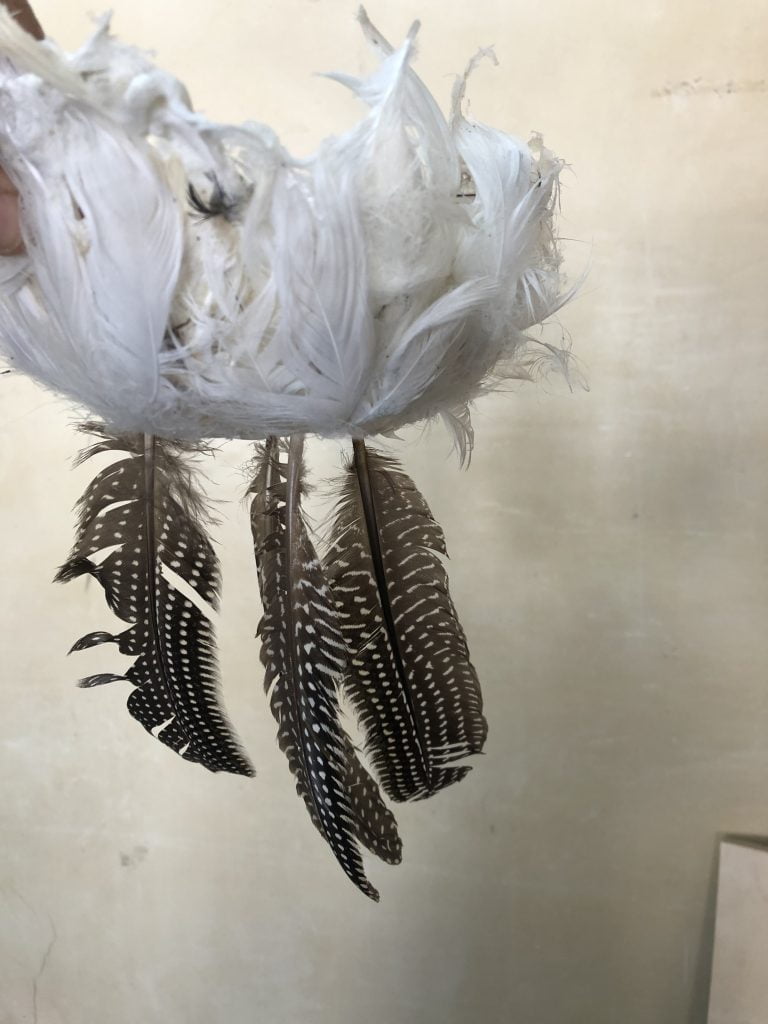
Other ideas came about care and patience and working with a gentle hand – fragility stays within the decision-making considerations. We looked at work by Irene Rammensee, who works with Japanese paper fibre. You started exploring paper fibre. At this stage, my daily drawing practice was to draw my hand – increasingly, I was aware of the gentleness of gestures of holding and touching.
In your reply, you mentioned the holding/cradling experience as sensual, shared your making of a small coiled vessel, and referred to the Boro vessel we explored by responding to our making. Below is the coiled vessel that as you wrote, although small, took quite a few hours to make. I can imagine the softness of the wool, and the colours add to the warmth of the texture. I wonder about the size of the object; what was your intention? I like the idea of different sizes of vessels – I wonder if you have placed this next to your other vessels to play with scale.
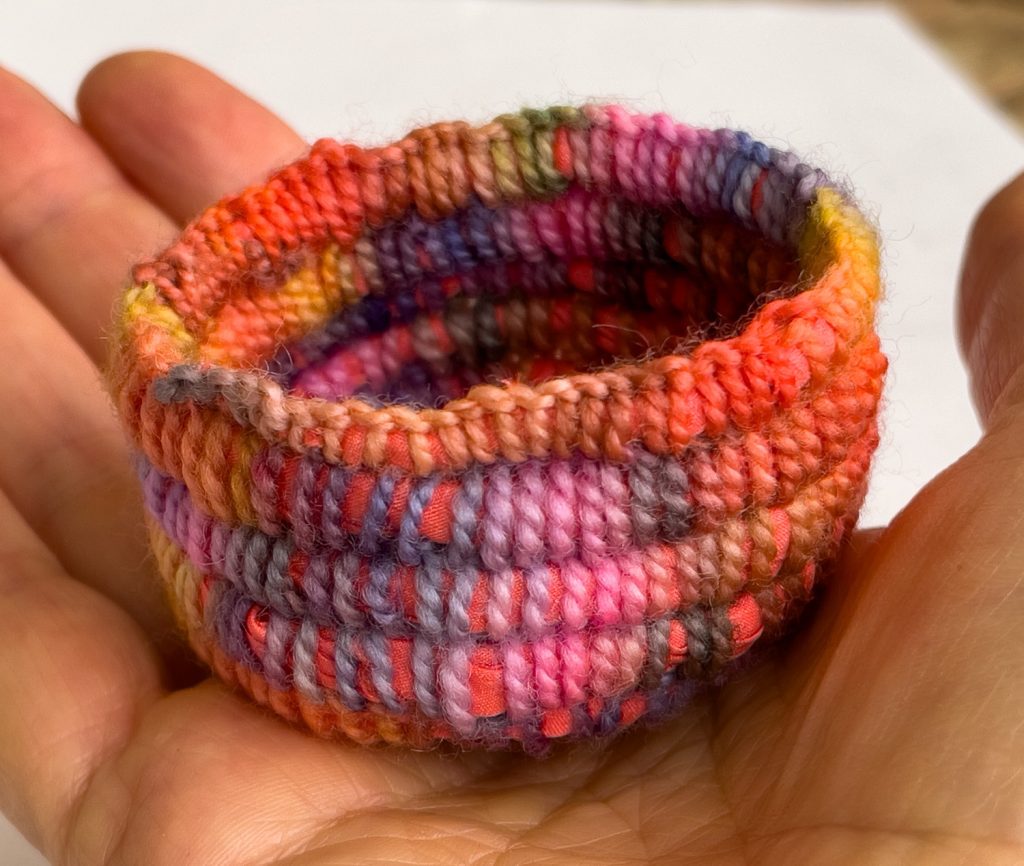
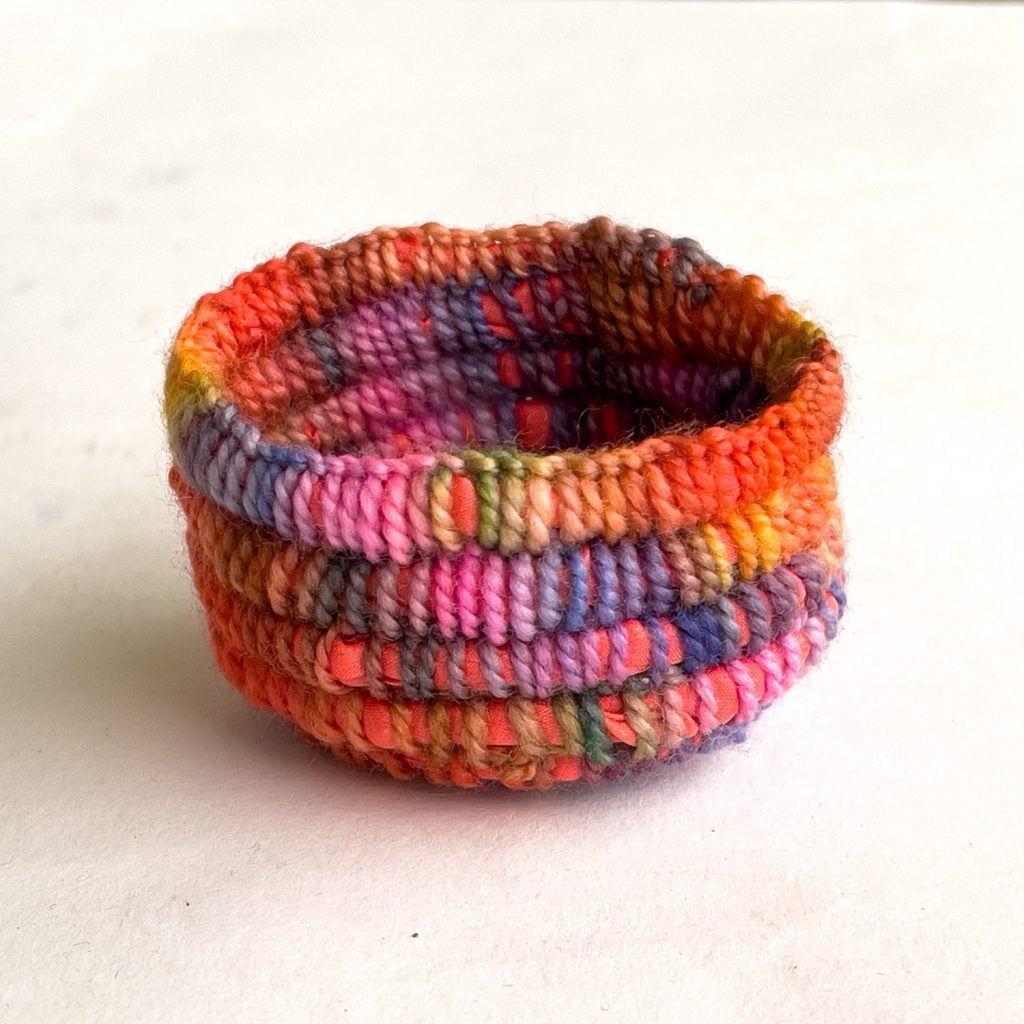
In early May, you shared a Boro vessel you made, and ideas were exchanged that my hand drawings influenced your perception. The folds in the vessel were reminiscent of the fingers of an open hand. You had to use cellulose paste on the bottom of the vase to keep it stable. I drew a hand holding the vase to maintain the soft folds together. I love how the hand can ‘cradle’ the vessel.
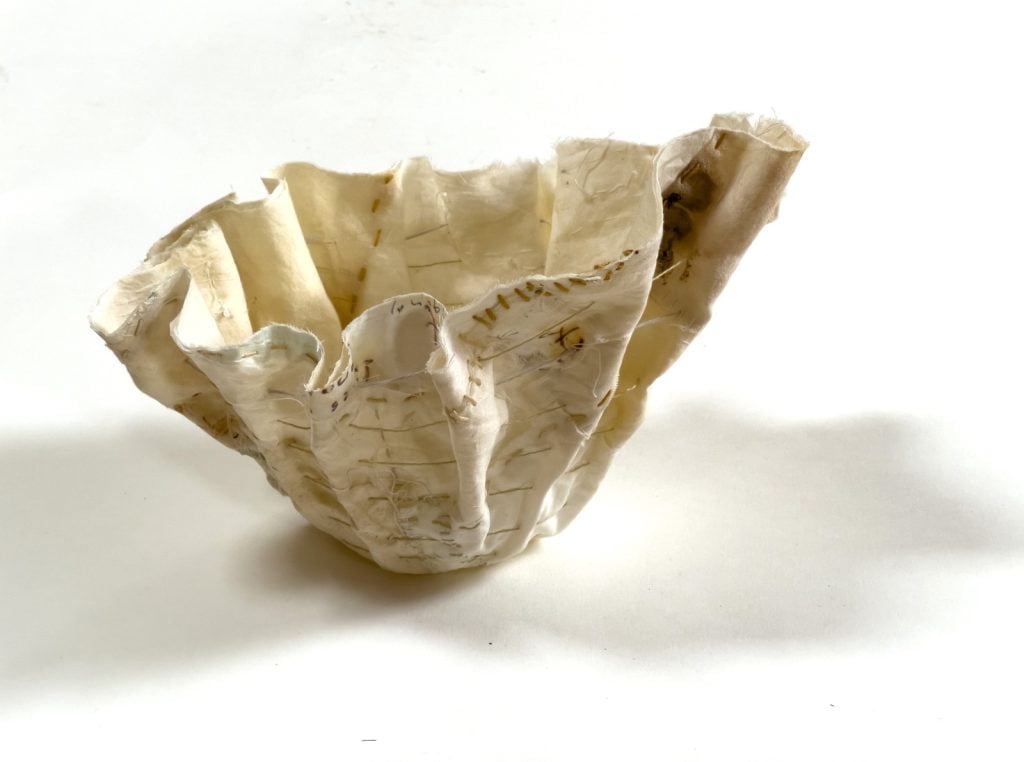
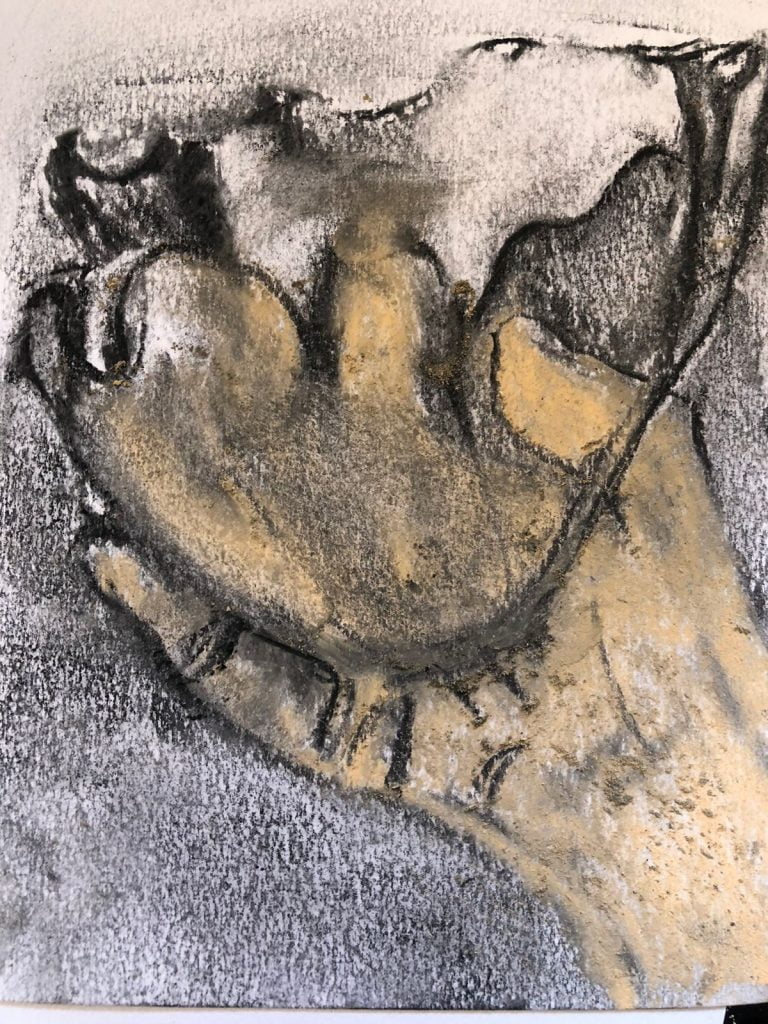
I later explored using an abstract feather and mushroom spore drawing to layer it onto your image as a digital work using a smartphone App. This work explores how a vessel can be decorated or how a painting/drawing can be reused to make a vessel. This inspired me to make more abstract drawings on Japanese paper, which I can use to create soft vessels to accompany my work.
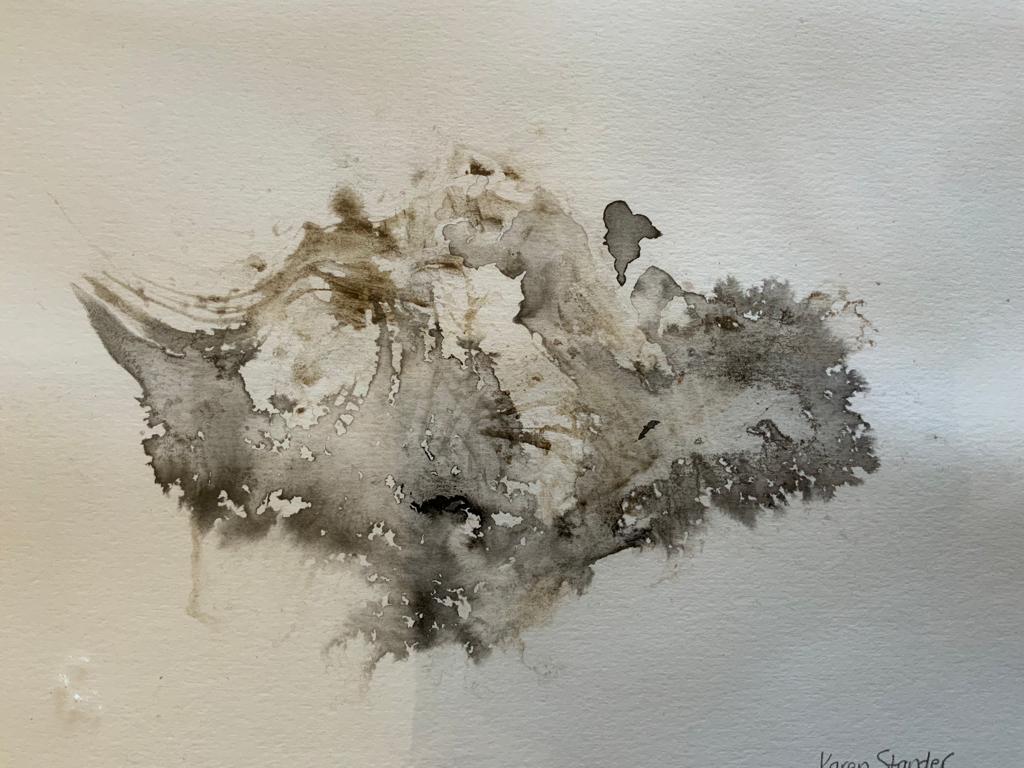
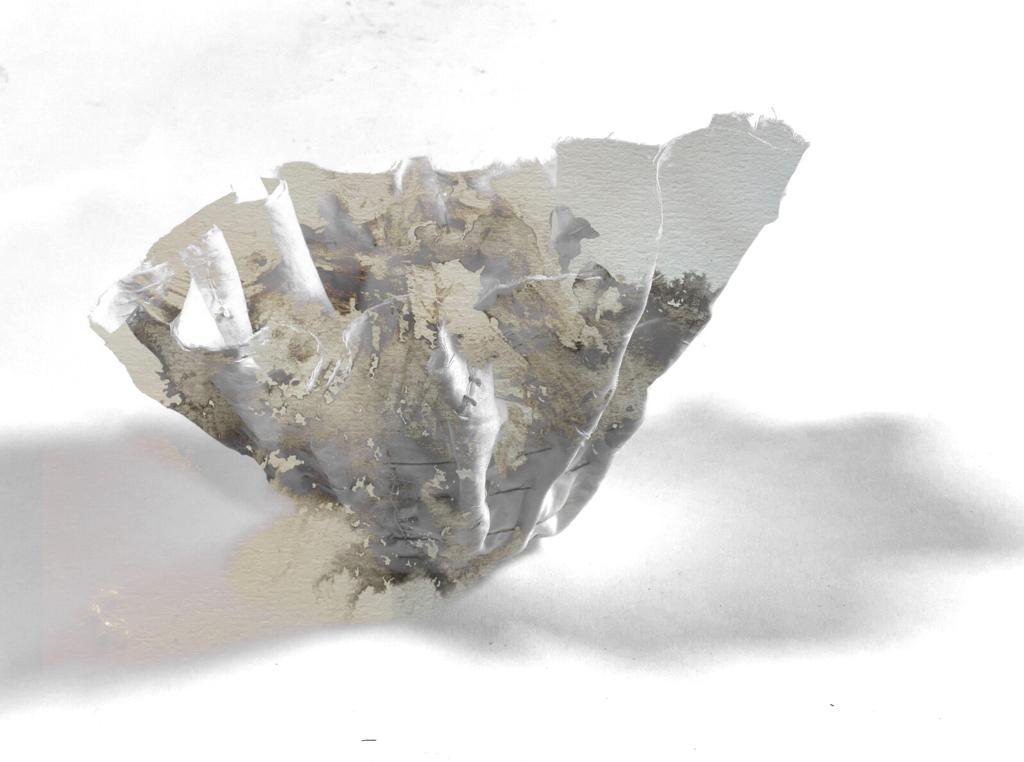
During level 2 studies, I looked at Moon jars made by Korean artist Mimi Young; the work below is called A Lot of Goodnights. Here she reflects on the meaning of saying goodnight, even how the earth says good night through the rising moon. I love the quietness in the work. On IG she shared a video of her making such a vessel (the orange one in the image below). She calls it, A Lot of Goodnights in Orange, 2022. This work is a layering of words as the continuous process of building and forming the shape. I like the repetition in the process of making and using words or text repetitively. On her website, I read the following comment: The entwining nature of collaboration is both liberating and suffocating, I think this is so true for us as humans to learn to be interdependent and less about ego. The light in these vessels is captivating.
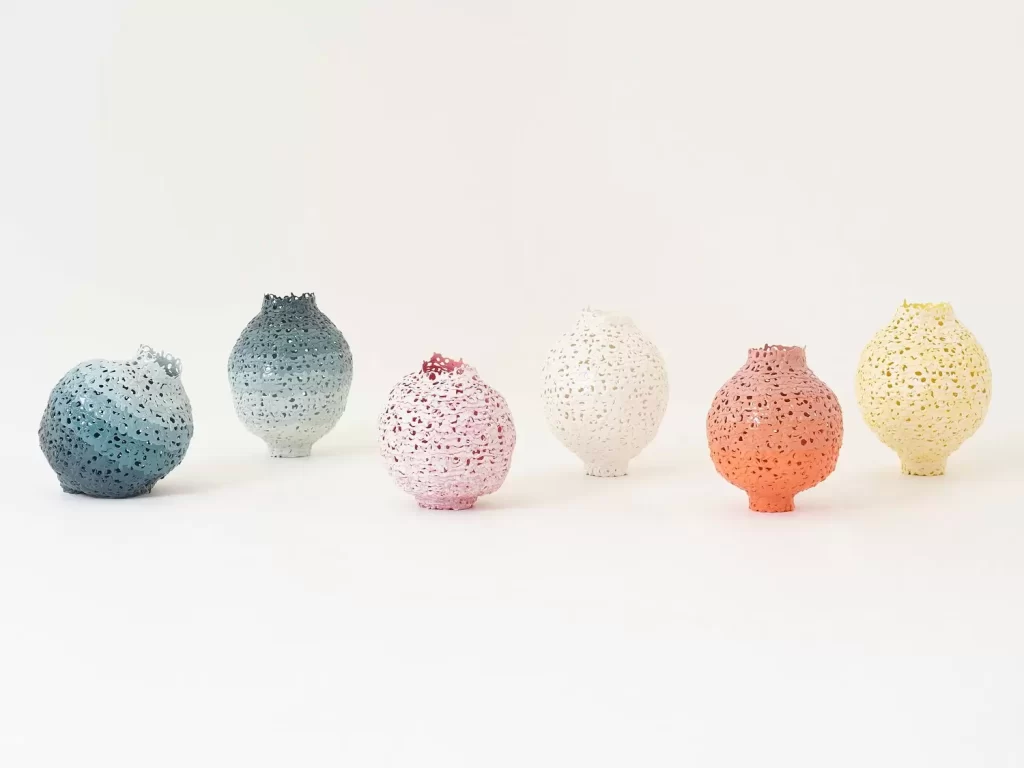
A note to self: I am reminded of reading Arjun Appadurai during Visual Culture studies, level 2, in the way that I am considering documenting the biography of the making (objects) between us. I also want to view the work I read by Tim Ingold. In my current OCA study work in Advanced Practice, I was looking at ‘returning’ and ‘preoccupations’ to themes and subject matter, materials and processes time and again, and how new insights or experiences come along. I am grateful for this collaboration, which brings new voices into my practice. I have also started a conversation with an engineer/academician interested in collaborating with me on our energy crises and renewable energy ideas and how art as an experiential approach to transformation could influence how we think and deal with them.
ps. I hope you had rain and that you enjoyed your gardening. I use the Grammarly app to ensure assistance with language, and the new addition of generative AI assistance suggests replacing the word ‘vessel’ with boat or ship, haha.
Bibliography
Appadurai, Arjun, 1986. The social life of things: commodities in cultural perspective. Cambridge University Press
Armstrong, John, de Botton, Aiain, 2013. Art as Therapy 9th printing 2011, Phaidon Press, London.
Moon So-young. 2014. The therapeutic quality of moon jars. https://koreajoongangdaily.joins.com/2014/05/20/columns/Therapeutic-quality-of-moon-jars/2989434.html
List of Illustrations
Reply received per email on 30 May 2023 (13:04)
Hi Karen,
Your writing is wonderfully vivid. I didn’t realize to what extent we have influenced each other. This feels so motivating – to witness that something one makes or says finds resonance in unforeseeable ways.
The analogy between body and vessel captivates me. All the concepts we connect with vessels – hold, store, protect, carry, filter… – apply to the body as well. I wonder in what way my fascination with porousness and transparency in vessels is connected to the body – its orifices, the skin as a permeable membrane – in constant exchange with the environment.
We can perceive vessels in a much wider sense. E.g. my little weaving around the metal plate was not intended as a vessel. But now I see it as a container protecting the fragile metal plate which is crumbling around the edges, allowing it to be hung up e.g.
Another interesting topic to investigate is the interaction between vessel and content. My metal plate will rust the weaving, over the long time destroying it. Flexible containers are deformed by their content. Chemical reactions, staining. Like what we put inside our body shapes it.
No rain here – slowly filling my water ton in the garden with water from the kitchen to water my plants for the next 2 weeks as I’m going to Bern tomorrow.
– Annette
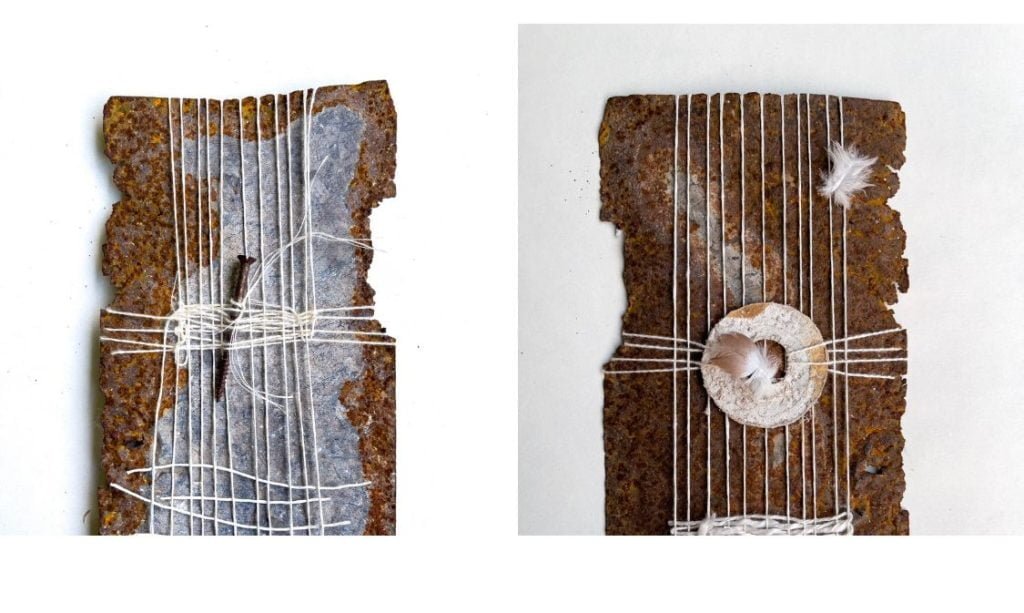
Reply 1 June 2023
It is a cold a foggy day – I can hardly see anything outside the windows from where I am writing.
I recently discovered the work of Meg Viney, who considers the vessel’s essential nature as female. I understand this as my ideas about emotional and spiritual holding place or, in her word, ‘containment ‘ – that capacity to contain your child resonate. It reminds of your analogy between the body and the vessel. For her, this containment is about emotional, spiritual and physical security. The writings of dr D W Winnicott, a paediatrician and child psychiatrist, inspired her. I do like her idea of linking vessels as things that held and nurtured the gestating form from conception to emergence (to how living entities emerge from vessels), – be it an egg, a cocoon, a uterus, a bud, a seedpod, a shell and gestate from in there. I remember that Ursula le Guinn names the body as a primary container – a container for the thing to be contained. I remember that Inger (a fellow group member) shared this pdf with us a few months ago. ( I saved the pdf)
I do like to see process and time woven into this story, and it takes me to how things are made in our studios; I think both of us enjoy the making process and do not mind the time it takes. It is as if our objects are not ‘consumables’ or thought of as instant. I do like this time of slowness that has come over me. (the sun is even slow to breakthrough into the day, which is now already past 10 am)
Meg Viney prefers to work with natural fibres and experimented with their flexibility to create form. This reminds me of the experiences you have shared. So her materials are plant fibres, grasses, branches, felt and feathers. I have no idea how the feathers are imprinted onto the felt in the container below.
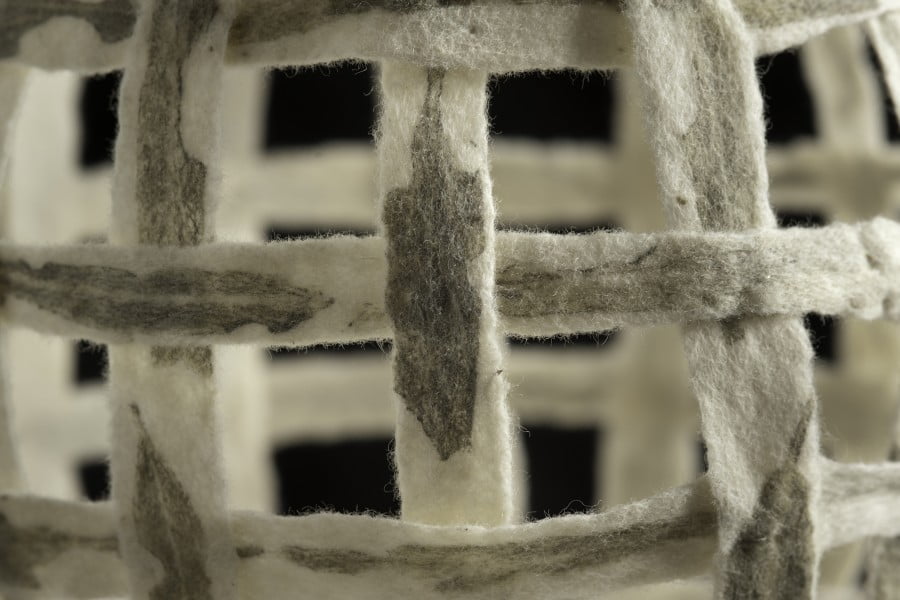
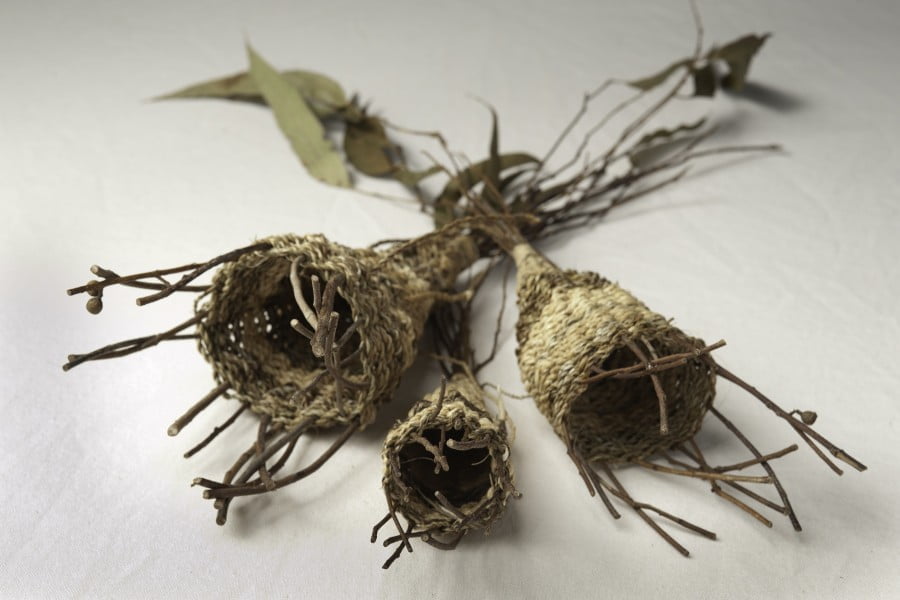
I enjoy these basket/nest works; they remind me of what you wrote about it being a container in a broader sense. I share my nest drawings and collections of weaver birds’ nests I have. Poor weaver males have it hard to please their female partners. I have used some of these nests to place mushrooms in and see it as an ideal mix for growing mushrooms, which will soon start, as winter and cooler temperatures are now prevalent. As natural material could become containers for growth or making with mushrooms
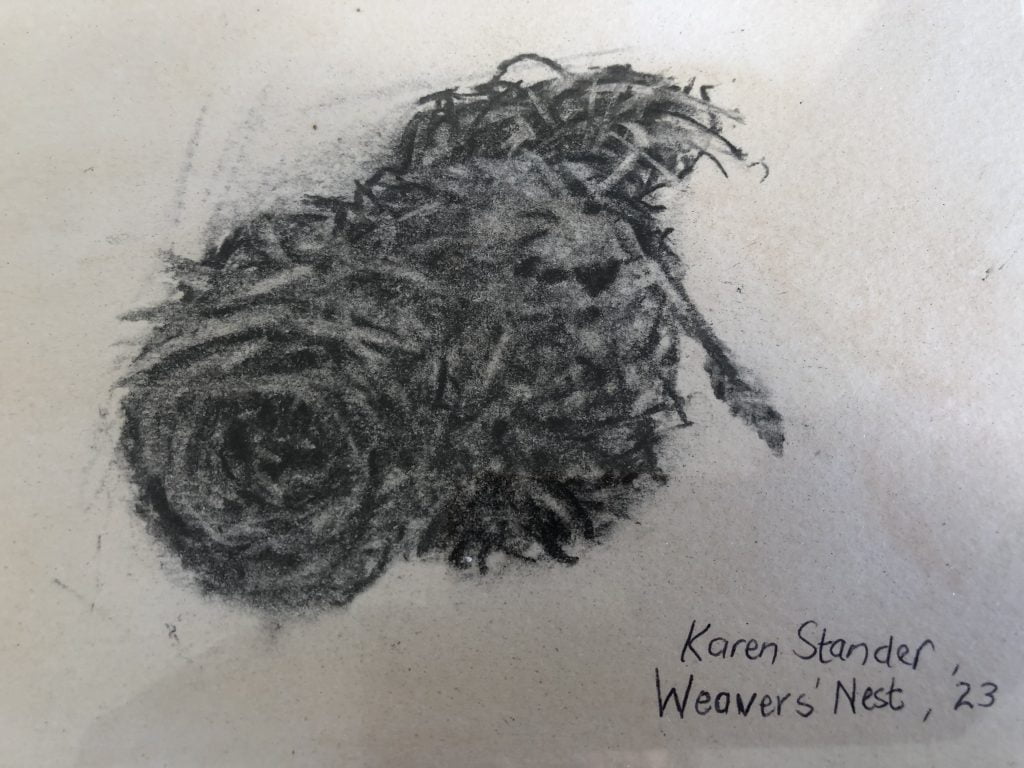
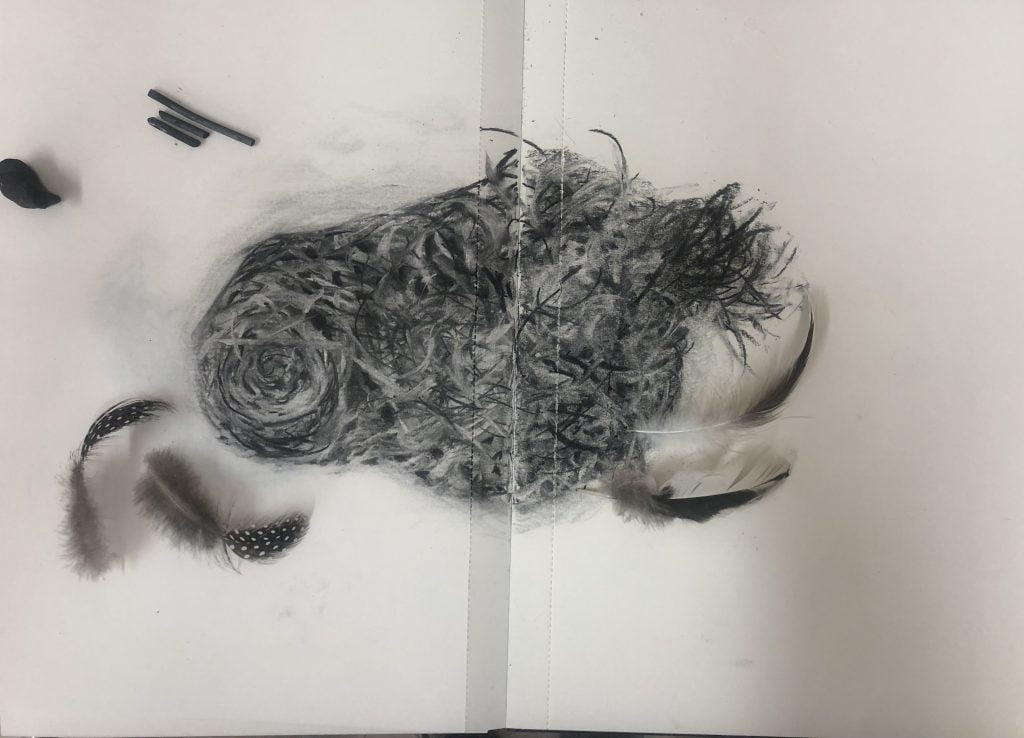
I am pondering on the vessel and content. I like paper mache and how it exposes light – your words are porous, and the transparency stays with me.
Ps. found good reading material on weaving a basket: Tim Ingold, The Perception of the Environment, chapters 18 and 19. A link to read is: https://leiaarqueologia.files.wordpress.com/2017/08/the-perception-of-the-environment-tim-ingold.pdf. I add this to my ever-growing reading list.
Tim Ingold:…. “that the human body should be understood as a kind of vessel into which social and cultural content can be poured..”
Now I will get into my studio,
Karen
10 June 2023
I shared this blog with my husband. Our vessels making reminds him of the cave in Plato’s story – to him, the cave tells a story about a vessel we create for false belief, but by letting the light in, it shows a different view, something we have a choice in, and many people do not allow that to happen. To him, that vessel could be a containment, but – it needs a crack…. an opening – to let in light, new insight, growth, change, and adapting. He enjoyed reading what happens in our making, to us as artists, and how the making is this place to react to life and questions, we have. This thought brought more questions about why we make. (how the viewer perceives the artist?) Is it that our art-making is a symbolic vessel that shares a personal journey of learning and creating and that we discover in the making a way to ‘let in the light?’
I also considered that our work is about tactile vessels – but what happens between us is implicit, in which we contain and house friendship, sharing, trust, and meaning, which goes for life, in our family structure and other connections. (that porousness you referred to earlier, ‘in constant exchange with the environment’?). The vessel below was made with dirty and ink-stained rags I have been using when printing – it carries marks of my making of other things. I added a hand to the vessel to remind of holding and caring.
Considering climate and sustainability, I think containment can be about environmental challenges and sustainability – questions and ideas about how we contain carbon dioxide in the atmosphere immediately come to the front. My vessel below reminds me of dirt contained within the vessel – learning from trees that take carbon dioxide out of the atmosphere and store it.
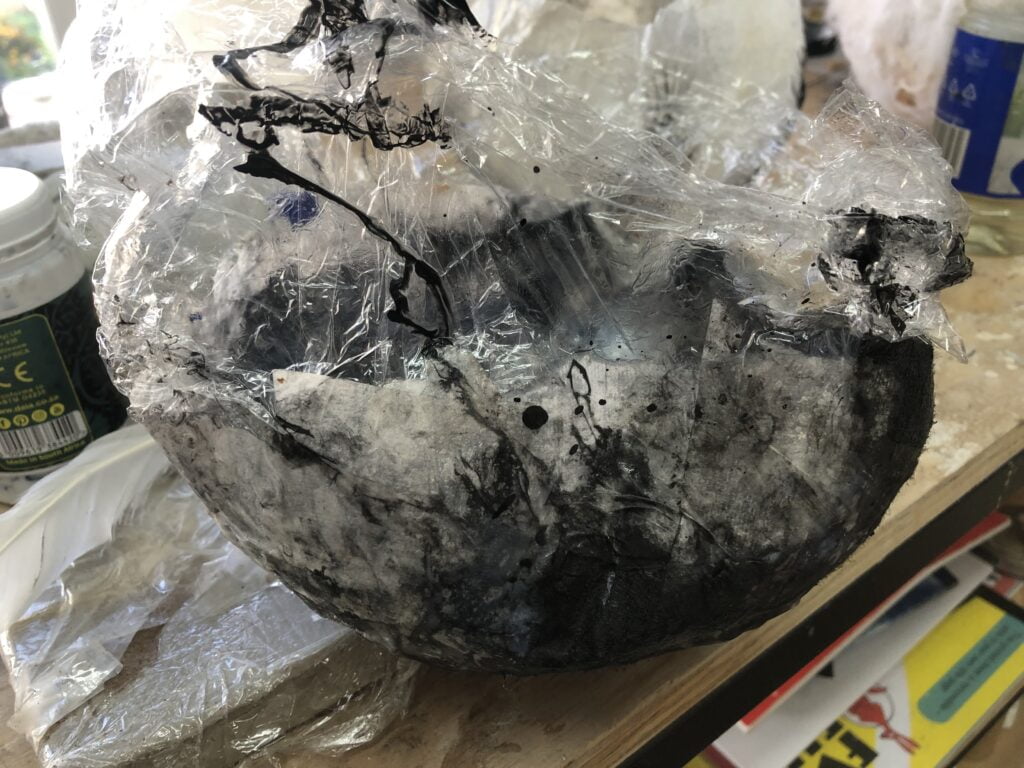
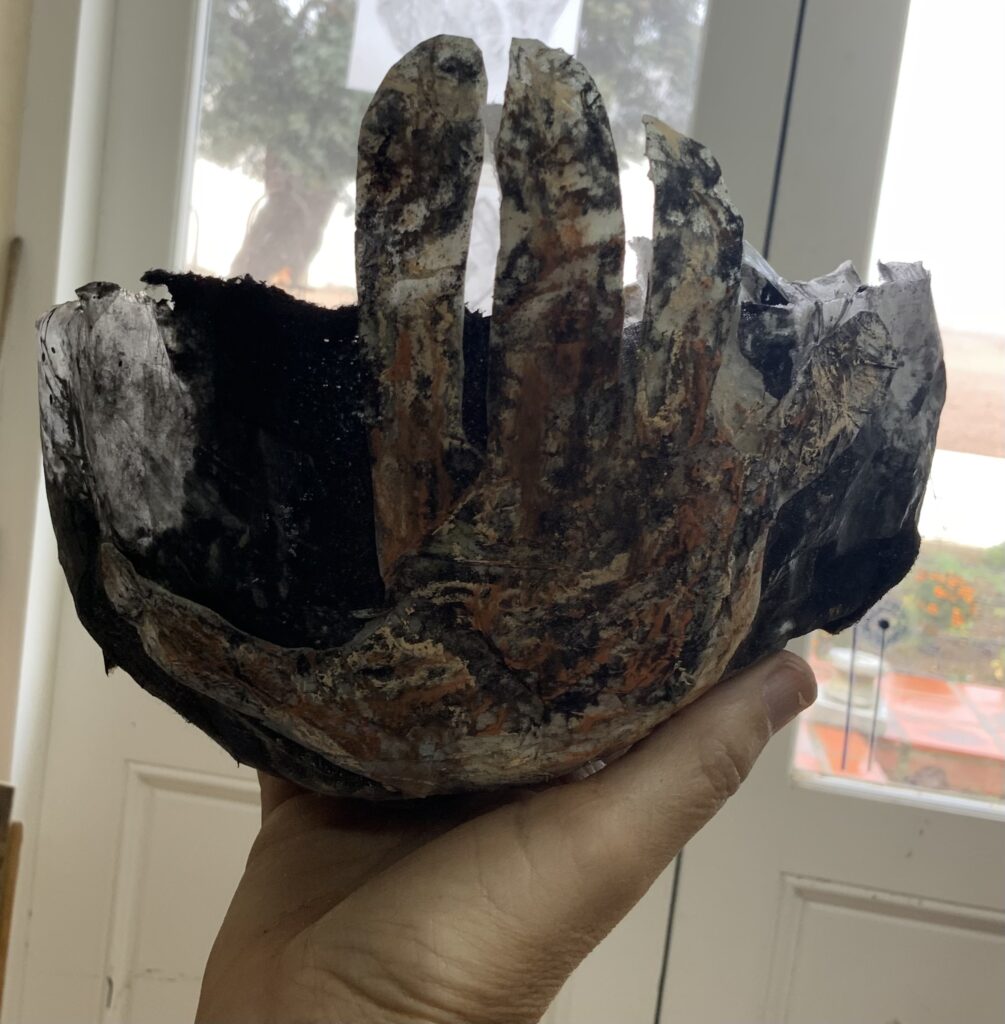
I asked myself, what if I look at the Earth as a container of life and ecosystems? The planet holds and sustains many organisms, supporting diverse habitats and intricate interconnections. Can I explore the idea of being a vessel for life, nurturing and protecting the delicate balance of nature in my art-making? I also want to move around ideas about interconnectedness: How does the earth act as a vessel for interconnected human societies? Thinking about how people share resources, cultures, and knowledge across continents and oceans. I feel strongly that the Earth holds and sustains our collective human experiences. I then agree with Kimmenerer when she talks about relationships of gratitude and reciprocity which, if developed, can increase the evolutionary fitness of plants and animals. Words like respect, gratitude, generosity, relationship, and reciprocity can be woven into my work and life philosophy. Kimmerer talks about a story we have told ourselves (the social construct of a commodity economy), and we are free to suggest another to reclaim the old one.
Robin Wall Kimmerer poetically shares ideas of kinship and the power of the collective in her book Braiding Sweetgrass. She called it an intertwining of spirit, science and story (03:20 3:44 in audible). I am touched by the idea that all flourishing is (should be!) mutual – how to bring this to our cultural, political, and economic views of haves and have-nots, imbalances and exploitation, and survival of the fittest? Her words, which I could use as an intention in my making and that stuck with me, are: “From the beginning of the world, the other species were a lifeboat for the people. Now we must be theirs.“
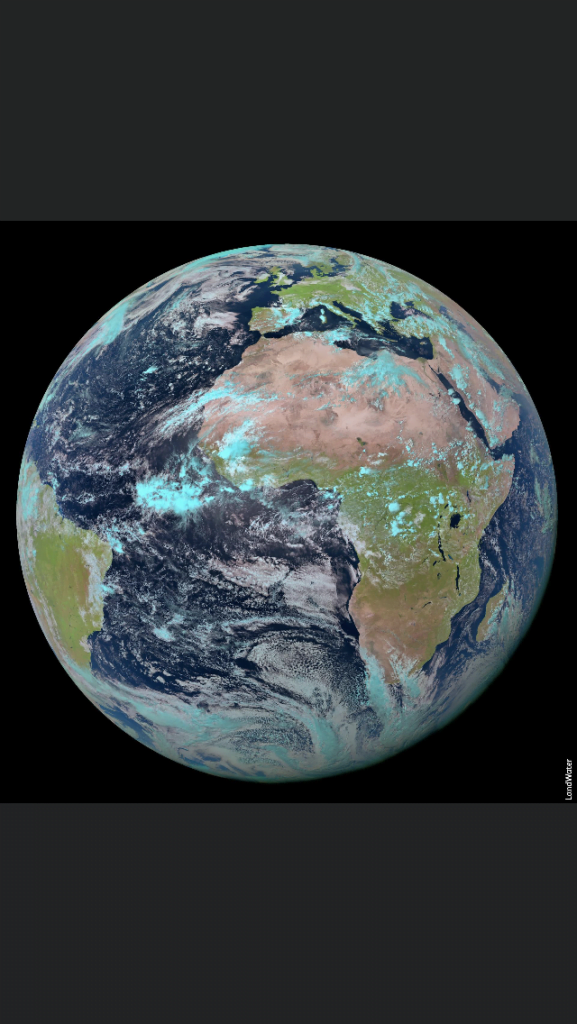
Sharing personal journeys in art – the expressing rises again. Is it about where we are in our lives and sharing this experience? I imprinted a mushroom spore onto a clay hand I formed, hoping the spores would infiltrate the medium. I have to wait and see if a connection will happen. I battle to keep the conditions to grow mushrooms at the moment – it is getting colder, and due to my injury, being hospitalized and away from my studio, my caretaking of this work was not always sufficient.
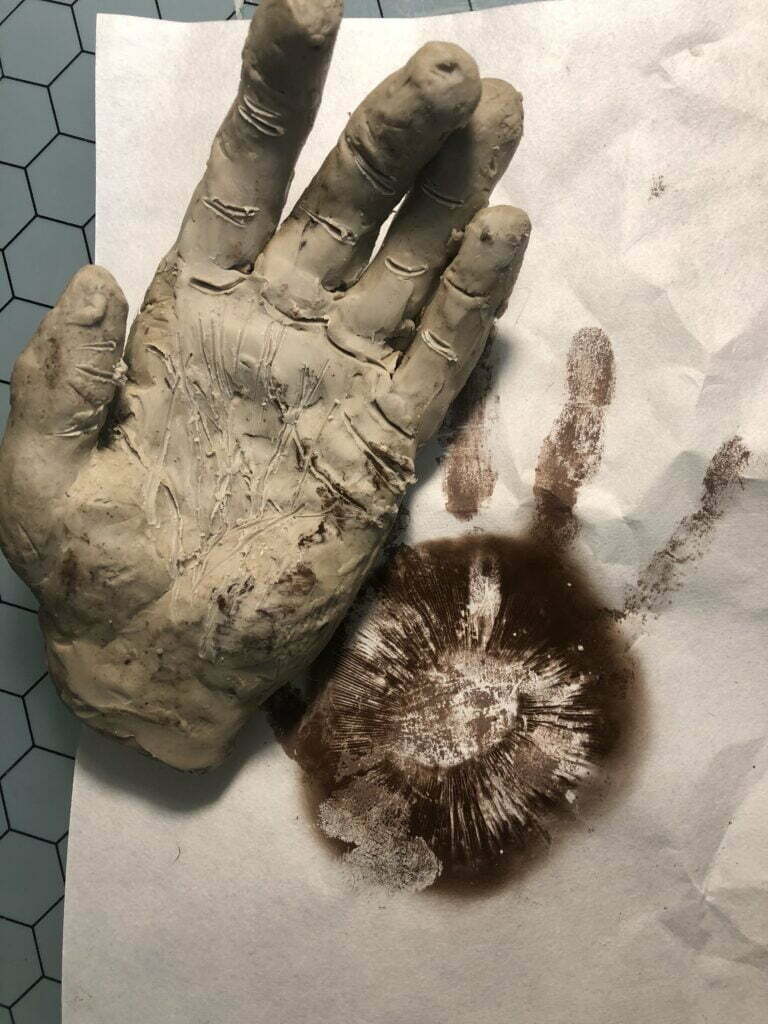
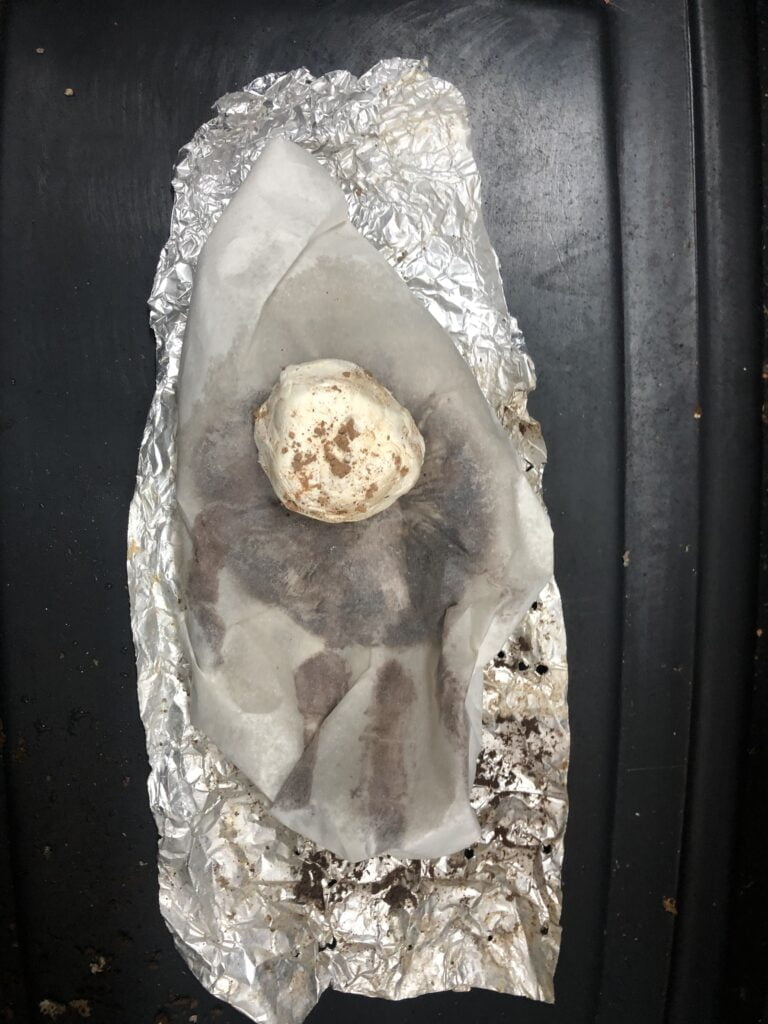
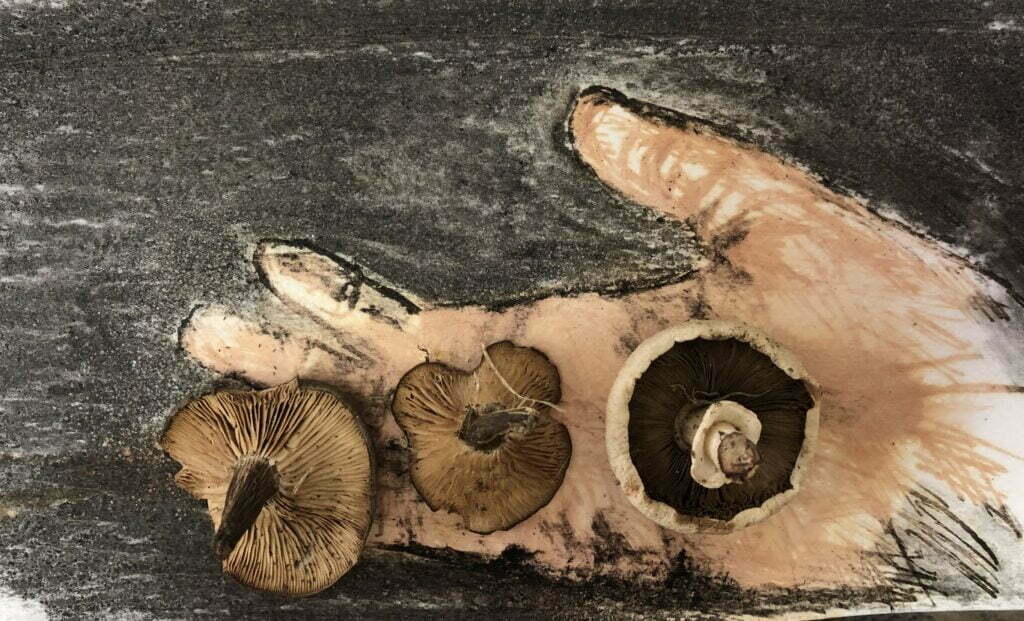
I am struggling to find a ‘container’ for my research methods, and I look at Donna Haraway and Karen Barad and their post-humanist theories. Still, I am instinctively pulled to the ideas (metaphors included) of Robin W Kimmerer in Braiding Sweetgrass, which also links to the African concepts of Ubuntu.
To ensure a liveable future for the following generations, we, as mortal “critters”,** need to link up ourselves with multiple configurations of places, times, matters and meanings so that new life can be “composted” from the planet-destroying Homo sapiens. Haraway, Donna: Staying with the Trouble: Making Kin in the Chthulucene, 2016.
** An American term for “all kinds of creatures”, used by Haraway for microbes, plants, animals, humans, non-humans and machines.
Bennet also caught my attention as Material vitalism suggests that life is an emergent property of certain complex material configurations. In this theory, the body is not merely a collection of inert substances but a material arrangement that gives rise to life. This perspective bridges the gap between the material and the vital.
I wonder if my making is about how I am trying to find answers to ‘composting’ a more sustainable life.
1 July 2023
I have now considered my ideas as shapes which revolve around circles, reminding me of vessels/containers which occur naturally in nature or are made by non-human makers – birds, mushrooms, plants, and wind. I like to think of it as approximations for pi – the ratio of a circle’s circumference to its diameter. I cannot draw a perfect circle on my own, and I like to think of these forms as how nature puts circles together and tend to look for secondary meanings, such as containment, safety, etc.
Crop/grass circles are intricate, bewildering patterns that have long confounded people, even igniting speculation about extraterrestrial activity, although more reasonable explanations cite either wind patterns or human interference. The Fairy circles in Africa embody a similar degree of mystery to me.
A bird nest can be aptly described as a container, symbolizing nature’s ingenuity and craftsmanship. It provides a protective haven, cradling the fragile wonders of avian life and showcasing the remarkable adaptations of birds as they navigate the natural world. In summary, bird nests are containers because they provide shelter, security, storage, and even transportation for eggs, nestlings, and sometimes adult birds. These intricate structures demonstrate birds’ remarkable instincts and adaptability in creating safe spaces for their offspring.
The nest’s structure, typically composed of twigs, leaves, grass, and various natural materials, forms a well-defined enclosure. Its bowl-like or cup-shaped design features a concave depression, gently holding the eggs and nestlings snugly in place. The exterior walls are woven tightly, acting as a protective shield against the elements and potential predators.
Just like a container, the nest acts as a barrier, shielding the vulnerable life inside from harm. It embraces the eggs and young birds, cocooning them in a realm of warmth and security. The meticulous construction ensures stability, preventing the precious contents from rolling or falling out.
While a spore print can have a circular form due to the shape of the mushroom cap, it doesn’t function as a container in the same way as a physical object. It is a two-dimensional representation of the spores released from the mushroom. It is simply a result of the spores being dispersed from the mushroom. The spores are not contained within the print; they are loose particles easily disturbed or dispersed by air currents.
However, metaphorically, one could argue that a spore print contains the potential for new mushroom growth. The spores within the print have the potential to germinate and develop into new mushrooms under suitable conditions. So, in that abstract sense, you could consider the spore print as containing the potential for future mushroom growth.
Saturday 29 July 2023
Online WA chat between Annette and me.
Annette shared a WA message after we shared that we both bought the same book, Finding Form with Fibre, by Ruth Woods. Annette concluded that she experienced our work sharing as inspiration because we often work with different approaches.
The course consists of learning different basketry techniques with other materials. It aims to help create sculptural pieces by examining shape and form. It is a self-paced online course with unlimited access to the material.
